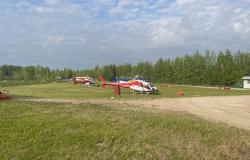
The number and intensity of extreme forest fires, the most destructive and polluting, have more than doubled worldwide over the past 20 years, due to global warming due to human activity, according to a new study published Monday.
Using satellite data, the researchers studied nearly 3,000 wildfires with high “radiative power” — the amount of energy emitted through radiation — between 2003 and 2023 and found that their frequency increased 2.2-fold during that period.
It is the temperate coniferous forests, particularly in the western United States, and the boreal forests, which cover Alaska, northern Canada and Russia, which are the most affected, with a frequency of such fires multiplied by 11 and 7 respectively.
Considering only the 20 most violent fires each year, their cumulative radiative power has also more than doubled, at a rate that “appears to be accelerating”, according to the study published in the journal Nature Ecology&Evolution.
“I was expecting an increase, but this rate of increase alarmed me,” said the study’s lead author, Calum Cunningham of Australia’s University of Tasmania.
“The effects of climate change no longer belong to the future and today we see the signs of an atmosphere that is drying and warming,” he told AFP, pleading for better preventive management forests.
The six most extreme years in wildfire intensity and frequency have occurred since 2017, the study found. Confirming the trend, it is the year 2023, the most recent, which experienced “the most extreme forest fire intensities” over the period studied.
These extreme fires are fueled by increasingly severe drought, a consequence of global warming.
During its growth, the forest cover absorbs CO2, but it returns en masse to the atmosphere when the vegetation burns, worsening global warming caused by greenhouse gas emissions.
This creates a “feedback effect,” Mr. Cunningham said.
In addition, with these fires, “vast regions are crossed by the plume of smoke, which has significant effects on health and leads to many more premature deaths than the flames themselves,” underlined the researcher.
His study cites in particular work according to which air pollution due to megafires in 2015 in Indonesia led to an excess mortality of 100,000 people.





